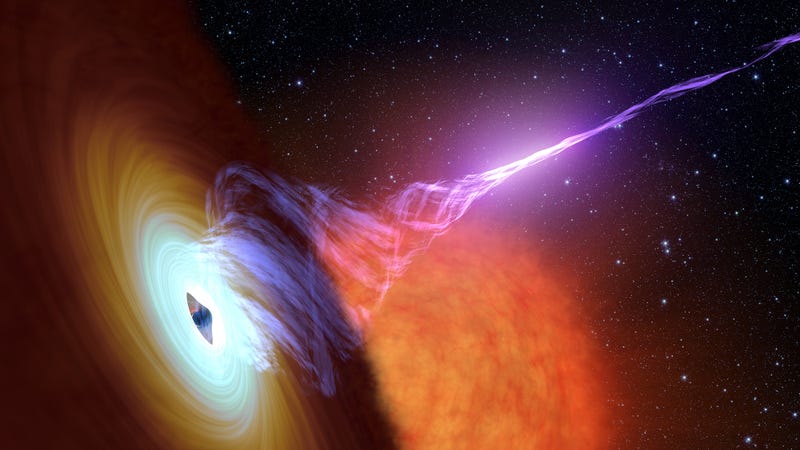 An artist’s conception of a black hole shooting a jet of plasmaIllustration: NASA/JPL-Caltech
An artist’s conception of a black hole shooting a jet of plasmaIllustration: NASA/JPL-Caltech
Black holes are already some of the strangest objects in the universe, and scientists sometimes dream up some pretty wild theories about their behavior. Like maybe they can accumulate dark matter particles and turn into black hole lasers, beaming radiation out into space.
This isn’t just someone’s fantastical idea. You might remember a mind-blowing theory from last year that linked a theorized dark matter particle called an “axion” with black holes and gravitational waves. This new theory is an extension of that—they’re called BLASTs, or “black hole lasers powered by axion superradiant instabilities.” The scientists behind it think there is perhaps a way to observe this strange behavior on Earth.
“I think it’s a fascinating possibility,” said Thomas Kephart, a Vanderbilt University researcher and one of the authors of the new paper. The work appeared recently in Physical Review Letters.
Here are a few key points: Dark matter seems to be mysterious stuff that permeates the universe, and whatever it is, it makes lots of things, like galaxies and clusters of galaxies, behave far more massively than they look. Axions are one of the many proposed explanations of dark matter, and are described as a super-light fundamental particle that communicates with the rest of the universe’s matter solely via gravity. Black holes are compact, mysterious objects so dense that light can’t escape their warped space.
Scientists who work on this stuff have previously postulated that if black holes rotate, then there’s a process called superradiance by which they can accumulate clouds with an incredible number of axions, like 1080, which is around the same number of atoms we think are in the universe. This results in what looks like an enormous atom with a black hole at its center instead of a nucleus, surrounded by a cloud of axions instead of electrons. Except you can’t stack more than a certain number of electrons around an atom’s center due certain fundamental laws of physics, while axions don’t have that constraint.
So, Kephart and his partner João G. Rosa from the Universidade de Aveiro in Portugal studied this strange superradiance effect further. According to their calculations, if the axion could decay into a pair of photons, this would excite other axions and cause them to release photons, and so on and so on. This chain reaction would stop and restart again as other processes balance it out, but could result in bursts of radio waves, or the BLASTs.
Basically, the scientists think that some of the fast radio bursts we always write about might be BLASTs coming from freaky dark matter black hole lasers.
The scientists offer a few ways to detect the BLASTs in their paper. Perhaps a fast radio burst with certain afterglows might carry a special signature indicating the BLAST. More fast radio bust detections might also bolster the existence of BLASTs.
Of course, this proposal has its limitations. The scientists point out that their work contains approximations, including an approximation of the shape of the proposed axion cloud around the black hole. There’s currently no evidence that axions exist, though there are designated axion hunts hoping to find the particles.
But if you were planning on writing a science fiction novel any time soon, I guess black hole dark matter lasers is up for grabs.
[PRL]